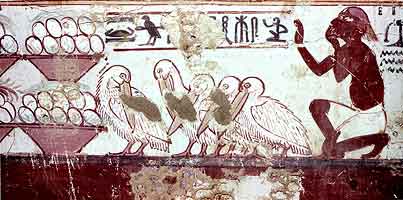|
||||||||||||||||
|
|
||||||||||||||||
|

Humans, Nature and Birds |
From Room 2: Birds as Resources for Human Use |
||||
|
|||||
 Plate 12 |
the science, to find out why the artist appears to have portrayed the shaggy-plumed Dalmatian Pelican (Pelecanus crispus), now a rare winter visitor to Egypt, rather than a White Pelican (P. onocrotalus) or a Pink-backed (P. refescens), which are also winter visitors; why grass appears below and above the eggs; whether two of the pelicans are preening or performing a courtship ritual; why priests were apparently forbidden to eat pelican meat; and, for that matter, whether the ancient Egyptians would enjoy eating the fishy-tasting meat and comparably fishy-tasting eggs.[24]
| ||||
Plate 12 Pelicans from a Wall Painting n the Tomb of Horemheb [untitled wall painting no. 78], (detail), Thebes, Egypt, early 1400s BCE Photo credit: George Hughes. Courtesy of the Oriental Institute of the University of Chicago. © 2008 Darryl Wheye and Donald Kennedy |
|||||